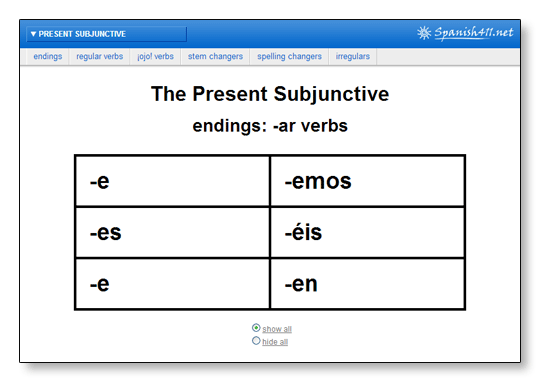|
|||||||||||||||||||||||||||||||||||||||||||||||||||||||||||||||||||||||||||||||||||||||||||||||||||||||||||||||||||||||||||||||||||||||
 |
|||||||||||||||||||||||||||||||||||||||||||||||||||||||||||||||||||||||||||||||||||||||||||||||||||||||||||||||||||||||||||||||||||||||
 |
|||||||||||||||||||||||||||||||||||||||||||||||||||||||||||||||||||||||||||||||||||||||||||||||||||||||||||||||||||||||||||||||||||||||
The Present Subjunctive: How?
See also: The Present Subjunctive: When? This page only deals with how to conjugate in the present subjunctive. To learn when to use the present subjunctive, see The Present Subjunctive: When? Regular Present Subjunctive VerbsTo conjugate a verb in the present tense subjunctive mood, we’re going to do something a little weird. First we conjugate in the present tense indicative yo form, then we drop the “-o” ending, and then we add the following endings: “-ar” endings:
“-er” / “-ir” endings:
Note: Because the yo form and él/ella/Ud. forms are identical, it is a good idea to include the subject pronoun yo to avoid confusion: Juan quiere que yo participe también. Take a look at the endings. You may notice they look very similar to the present tense indicative endings except that they’ve been switched; what look like “-er” endings are now used for “-ar” verbs, and what look like “-ar” endings are now the endings of both “-er” and “-ir” verbs. Notice, however, that there is no “-o” ending for the yo form. Some conjugation examples: hablar:
comer:
vivir:
And some examples in context: viajar → viajo → viaj-Me alegro que ella viaje a
otros países. correr → corro → corr-Esperamos
que tú corras rápidamente. escribir → escribo → escrib-Ellos
dudan que escribamos novelas. Based on these examples, you might be tempted to shorten the procedure a bit to just “remove the infinitive ending and add the subjunctive ending” but that doesn’t always work. Consider: tener → tengo → teng-Es necesario
que tú tengas tu tarea contigo. decir → digo → dig-¡Quiero
que ustedes me digan la verdad! conocer → conozco → conozc-Es
importante que tú conozcas bien a tus amigos. Because there are “-go” verbs and “-zco” verbs and many other verbs with unusual yo form conjugations, you must follow the rule: first conjugate in the yo form, then drop the “-o”, and then add the appropriate ending. Verbs with irregular yo forms keep that irregularity in all of the present subjunctive forms. Some examples: ofrecer:
hacer:
influir:
And don’t forget about other verbs with yo form spelling changes like these:
 Let’s practice! Conjugate regular present subjunctive verbs on ¡Practiquemos! Spelling ChangesAs you may recall from the preterite, switching “-a” endings with “-e” endings causes some pronunciation problems that need to be resolved by changing the spelling of the stem. The verbs we need to pay attention to are the usual suspects:
Some examples: Es necesario
que indiques tu preferencia. In the first two sentences above, if we didn’t change the spellings we’d be left with “indices” and “llegemos” and the pronunciation of their stems would no longer be consistent with their infinitive forms, indicar and llegar. In the case of “almuerce,” anytime we can use a “c” instead of a “z,” we should. They are fairly infrequent, but you also
need to keep an eye open for “-guar” verbs. They will need a La policía espera que él atestigüe. In order to keep the “gw” sound, we need to use a “ü” (rather than a “u”) once we switch from an “-a” ending to an “-e” ending.  Let’s practice! Conjugate present subjunctive spelling changers on ¡Practiquemos! Stem ChangersAll “-ar” and “-er” verbs that have a stem change in the indicative will also have a stem change in the subjunctive. That stem change will follow the same pattern as the indicative, which is to say that the stem will not change in the nosotros or vosotros forms: contar (o→ue):
perder (e→ie):
On the other hand, the stems of “-ir” stem-changing verbs will have an additional change in the nosotros and vosotros forms. Stem-changing “o→ue” verbs will also have an “o→u” change; stem-changing “e→ie” verbs will also have an “e→i” change; and stem-changing “e→i” verbs will have an “e→i” change throughout the conjugations: Note: These additional stem changes for “-ir” stem-changing verbs are the same as the ones you see in the present participle and preterite conjugations: durmiendo, sintieron, etc. dormir (o→ue, o→u):
sentir (e→ie, e→i):
pedir (e→i, e→i):
 Let’s practice! Conjugate present subjunctive stem changers on ¡Practiquemos! Irregular Present Subjunctive VerbsIt wouldn’t be any fun if there weren’t irregulars, right? In the case of the present subjunctive, there’s good reason for them. If you know that we first conjugate in the yo form, and then drop the “-o” ending, what do you do with these verbs: dar, estar, ir, saber, and ser? None of their yo forms end in “-o” (doy, estoy, voy, sé, and soy). Because of that, each of these verbs is completely irregular: dar:
estar:
ir:
saber:
ser:
Notice that the accent marks on all of these verbs are consistent with their indicative conjugations with the one exception. In the case of dar, the yo and él/ella/Ud. forms add what looks to be an unnecessary accent mark. The reason for this accent is to distinguish the verb conjugation, dé from the preposition, de. That takes care of the present tense, but remember that the subjunctive is a mood, which means we can also use it in other tenses as well. So what else do we need to know? See The Imperfect Subjunctive: How? and Other Tenses in the Subjunctive Mood.  Let’s practice! Conjugate irregular present subjunctive verbs on ¡Practiquemos! |
|||||||||||||||||||||||||||||||||||||||||||||||||||||||||||||||||||||||||||||||||||||||||||||||||||||||||||||||||||||||||||||||||||||||
 This work by Spanish411.net is licensed under a Creative Commons Attribution-NonCommercial-ShareAlike 4.0 International License. This work by Spanish411.net is licensed under a Creative Commons Attribution-NonCommercial-ShareAlike 4.0 International License. |

